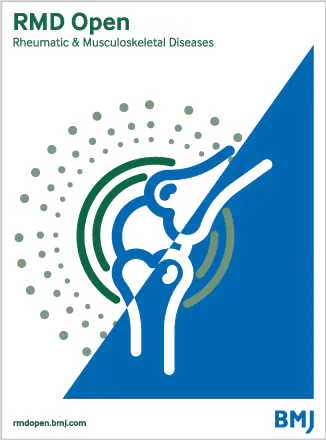E6742:Toll样受体7和8的双重拮抗剂,在系统性红斑狼疮的首次患者随机双盲I/II期研究中的安全性、药代动力学、生物标志物反应和疗效
IF 5.1
2区 医学
Q1 RHEUMATOLOGY
引用次数: 0
摘要
目的 在一项针对系统性红斑狼疮 (SLE) 患者的 I/II 期研究中评估 E6742 的安全性、耐受性、药代动力学 (PK)、生物标志物反应和疗效。方法 两组系统性红斑狼疮患者依次入组,随机接受为期12周、每天两次的E6742(100或200毫克;人数=8或9)或安慰剂(人数=9)治疗。主要终点是安全性,次要终点是PK和干扰素基因特征(IGS),探索性终点是疗效和生物标志物。结果 E6742组出现治疗突发不良事件(TEAEs)的患者比例为58.8%(100毫克为37.5%(3/8名患者);200毫克为77.8%(7/9名患者)),安慰剂组为66.7%(6/9名患者)。没有发生不良事件通用术语标准≥3级的TEAE。PK 参数与之前在健康成人中进行的 I 期研究相似。E6742治疗后,体内外Toll样受体7/8激动剂挑战后的IGS和促炎细胞因子水平立即下降。E6742 100 毫克组在第 12 周时的基于不列颠群岛狼疮评估小组的狼疮综合评估反应率为 37.5%(3/8 名患者),E6742 200 毫克组为 57.1%(4/7 名患者),安慰剂组为 33.3%(3/9 名患者)。结论 E6742具有良好的安全性和耐受性,对系统性红斑狼疮患者具有抑制IGS反应和初步疗效的作用。这些结果为E6742治疗系统性红斑狼疮提供了第一批临床证据,并为更大规模、更长期的临床试验提供了支持。试验注册号[NCT05278663][1]。如有合理要求,可提供数据。本研究中使用和/或分析的数据集可根据合理要求和赞助商的数据共享政策向赞助商提供。[1]:/lookup/external-ref?link_type=CLINTRIALGOV&access_num=NCT05278663&atom=%2Frmdopen%2F10%2F3%2Fe004701.atom本文章由计算机程序翻译,如有差异,请以英文原文为准。
Safety, pharmacokinetics, biomarker response and efficacy of E6742: a dual antagonist of Toll-like receptors 7 and 8, in a first in patient, randomised, double-blind, phase I/II study in systemic lupus erythematosus
Objectives To evaluate the safety, tolerability, pharmacokinetics (PK), biomarker response and efficacy of E6742 in a phase I/II study in patients with systemic lupus erythematosus (SLE). Methods Two sequential cohorts of patients with SLE were enrolled and randomised to 12 weeks of two times per day treatment with E6742 (100 or 200 mg; n=8 or 9) or placebo (n=9). The primary endpoint was safety, the secondary endpoints were PK and interferon gene signature (IGS), and the exploratory endpoints were efficacy and biomarker. Results The proportion of patients with any treatment-emergent adverse events (TEAEs) was 58.8% in the E6742 group (37.5% (3/8 patients) for 100 mg; 77.8% (7/9 patients) for 200 mg) and 66.7% (6/9 patients) in the placebo group. No Common Terminology Criteria for Adverse Events≥Grade 3 TEAEs occurred. PK parameters were similar to these in previous phase I studies in healthy adults. The IGS and levels of proinflammatory cytokines after ex-vivo challenge with a Toll-like receptor 7/8 agonist were immediately decreased by E6742 treatment. The response rate of the British Isles Lupus Assessment Group-based Composite Lupus Assessment at week 12 was 37.5% (3/8 patients) for E6742 100 mg, 57.1% (4/7 patients) for E6742 200 mg and 33.3% (3/9 patients) for placebo group. Conclusions E6742 had a favourable safety profile and was well tolerated, with suppression of IGS responses and preliminary efficacy signals in patients with SLE. These results provide the first clinical evidence to support E6742 in the treatment of SLE, and support larger, longer-term clinical trials. Trial registration number [NCT05278663][1]. Data are available upon reasonable request. The datasets used and/or analyzed during the current study are available from the sponsor based on reasonable request and the data sharing policy of sponsor. [1]: /lookup/external-ref?link_type=CLINTRIALGOV&access_num=NCT05278663&atom=%2Frmdopen%2F10%2F3%2Fe004701.atom
求助全文
通过发布文献求助,成功后即可免费获取论文全文。
去求助
来源期刊

RMD Open
RHEUMATOLOGY-
CiteScore
7.30
自引率
6.50%
发文量
205
审稿时长
14 weeks
期刊介绍:
RMD Open publishes high quality peer-reviewed original research covering the full spectrum of musculoskeletal disorders, rheumatism and connective tissue diseases, including osteoporosis, spine and rehabilitation. Clinical and epidemiological research, basic and translational medicine, interesting clinical cases, and smaller studies that add to the literature are all considered.
 求助内容:
求助内容: 应助结果提醒方式:
应助结果提醒方式:


